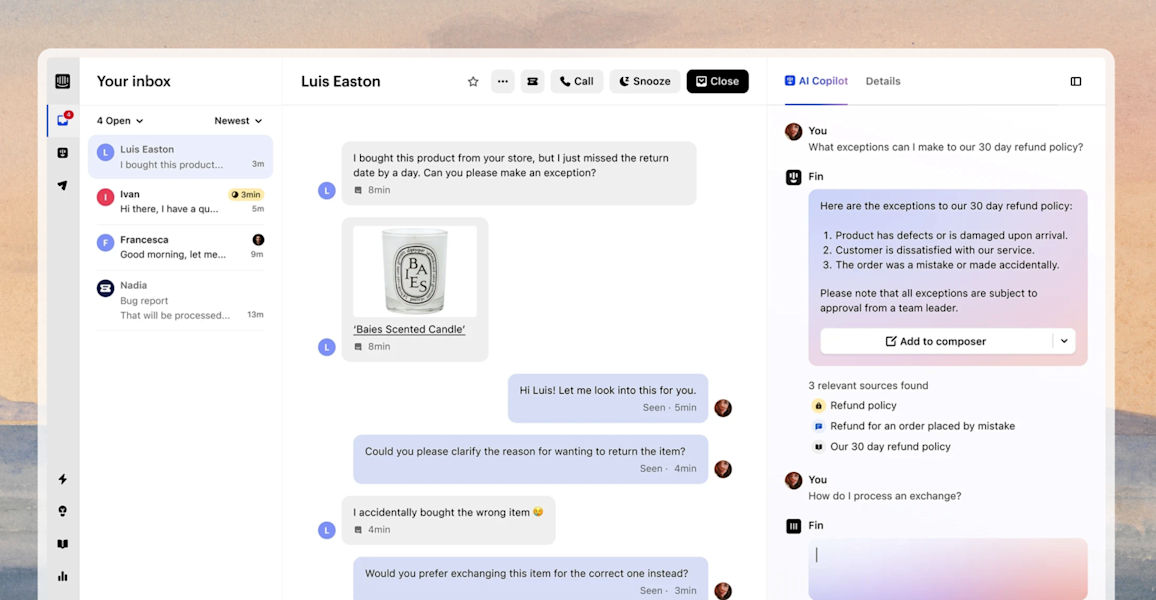Challenge
As a company with a history of technological innovation, Intercom was an early adopter of AI and machine learning tools to help power its customer service solutions. But with the launch of ChatGPT in December 2022, Intercom saw an opportunity to use the advanced capabilities of this new model to transform its products and business model. Through a partnership with OpenAI, the creator of ChatGPT, Intercom’s engineers began to rebuild its customer service platform from the ground up with GPT-enabled tools, the first of which launched just three months later and has since evolved to include AI Agent, AI Copilot, and more.
As Intercom was developing its AI tools, the company also knew it needed a new billing system that could handle the fast-paced and always-changing nature of AI-first products and billing. Over the years, Intercom had built a customer billing engine and internal billing administrative UI that connected to a third-party platform for delivering customer subscription invoices. That complicated arrangement made it difficult for Intercom to launch new pricing models or manage subscription variables like discounting and prorating.
The system was also prone to errors from poor integrations and data synchronization. Customer-facing teams couldn’t resolve these issues because the API connecting the internal billing platform to the subscription invoicing tool wasn’t easy to work with and lacked clear documentation. As a result, billing errors became a major technical issue for a team of seven senior engineers, one or two of whom were dedicated to managing billing errors and operational issues each week.
Intercom needed a billing platform that would make it easier to develop new subscription pricing tiers while also supporting optional charges, usage-based fees, and discounts as the company migrated existing customers to its products and pricing model. That platform also needed to offer efficient integration with several other systems in Intercom’s technology architecture, such as its NetSuite accounting software, Avalara tax engine, AWS data lake, and Salesforce customer relationship management (CRM) software.
Two-way integration with the CRM system was especially important because Intercom had two sales channels: self-service subscriptions for smaller companies through the Intercom website, and a salesforce that worked with larger companies. Creating a new billing platform was an opportunity to unify the subscription management experience for both channels.
Above all, the new billing system had to reduce billing errors and give customer-facing teams the ability to resolve any issues themselves—without calling in engineers.
Solution
Intercom chose to consolidate its internal and external billing functions onto Stripe Billing, which offered the functionality that Intercom needed immediately to support its new products and pricing models. Billing had the flexibility to easily complete third-party integrations with other key pieces of its technology architecture and connected seamlessly to Stripe Payments, which Intercom was already using to process subscribers’ credit card payments.
Stripe’s understanding of the key issues that billing systems must manage—including multiple pricing tiers, proration, discounts, the ability to test new products, and support for multiple payment methods—gave Intercom confidence that Billing would evolve to support the company’s own roadmap for continued growth and innovation. For both Intercom and Stripe, billing systems are not merely a finance function but a key platform that must support a company’s product development, core processes, business model, and customer experience.
Before starting the migration, the Stripe professional services team led a detailed feasibility assessment to understand Intercom’s current challenges, existing technology architecture, and future needs. Over three months, Stripe interviewed key stakeholders who interacted with the billing platform, including product managers, billing engineers, and members of the accounting and accounts receivable teams. These conversations helped ensure the migration to Billing would support each party’s needs and integrate with Intercom’s complex internal systems.
The feasibility assessment resulted in a three-phase implementation plan. First, Intercom would roll out its updated products and pricing models for new customers on Billing. The second phase would migrate existing customers to the new products and pricing models. In the third phase, Intercom would migrate its remaining existing customers to Billing but keep them on legacy pricing models until they upgraded to new products.
To manage the first phase of the project, Stripe professional services coordinated an implementation team that included experts in the US, Dublin, and London, who worked closely with Intercom technical, finance, and operations stakeholders to map a new billing architecture. Intercom’s new pricing models included three subscription levels to serve different sized businesses with per-seat pricing that reflects the level of features included in each tier. That pricing includes usage-based charges for certain features and channels, as well as fees for optional add-on services—all of which would be reconciled in a customer’s monthly bill.
The Stripe professional services team continued working alongside Intercom’s team throughout the implementation, sharing technical and operational best practices to help ensure a successful launch. The teams set up new products, prices, and billing rules, and connected Billing with other systems in Intercom’s technology architecture using a mix of prebuilt connectors and custom integrations. For example, the implementation team connected Billing with Intercom’s Avalara tax engine using the AvaTax for Stripe prebuilt connector, which listens to webhook events from Stripe Invoicing to calculate and remit taxes based on the country where the invoice is issued and the customer’s country. To connect billing with Salesforce, Intercom used the Stripe API to build a custom integration layer.
As Stripe users, Intercom also gained access to a Stripe Dashboard, which provided detailed visibility into customer subscription levels, invoicing data, and payment status. Prior to launching the first phase of the new billing platform, the Stripe implementation team gave a tutorial to the Intercom billing operations team, showing them how to use the Dashboard to identify billing issues and respond to customer requests.
Results
Five months to roll out new pricing to first-time customers
Thanks to detailed planning and the flexibility of integration options with Billing, Intercom completed the first phase of the migration within five months, coinciding with the launch of its new pricing plans in November 2023.
Intercom is working through the remaining stages of the implementation plan. By July 2024, it had migrated 20% of its subscription customers and 12% of its revenue to Stripe.
“Incremental adoption of Stripe Billing allowed us to accelerate the evolution of our billing systems while reducing any risk of disruption for our existing business,” said James Treanor, a senior product engineer at Intercom. “As we have built confidence and operational expertise in Stripe Billing, gradually moving customers to the new system has enabled us to keep this high-velocity/low-risk approach.”
New billing platform supports flexible subscription pricing models
Migrating to Billing allowed Intercom to introduce a simplified, seat-based billing model with the ability to offer line-item-level discounting for certain customers—a feature the company was unable to offer with its previous provider.
“Introducing our new pricing model with Stripe allowed us to iterate quickly and with as much flexibility on pricing as we needed,” said Treanor.
Consolidating into a single platform gives engineers more time to work on new products
By eliminating the third-party layer between the billing engine and payments, Intercom expects to see a significant reduction in billing errors as it moves forward with the implementation. In the future, Intercom will also be able to retire its in-house usage-based billing engine and migrate that process to Stripe.
What’s more, because there is no longer a black box API connecting those systems, customer-facing teams can easily log in to Stripe and resolve most issues without having to escalate questions to the engineering team. The company’s senior engineers aren’t stuck doing “keep the lights on” work, meaning they can focus instead on building new products and refining Intercom’s core AI-powered customer service tools.
“Stripe Billing is far more developer friendly than our old setup,” said Kevin McNally, a senior machine learning engineer at Intercom. “With its better documentation and more intuitive core concepts for subscription management, it is much easier for our team to make incremental changes.”
By switching to Stripe, Intercom has aligned its billing strategy with its product and customer experience goals: delivering a world-class experience that emphasizes simplicity and prioritizes continual improvement rather than maintaining the status quo.
Our goal is to deliver simple, transparent, and flexible pricing that puts our customers first. We chose Stripe not just because of the range of pricing model options, but also their incredibly high bar for excellence and ability to move fast. That’s exactly the type of experience we want to deliver to our customers.

